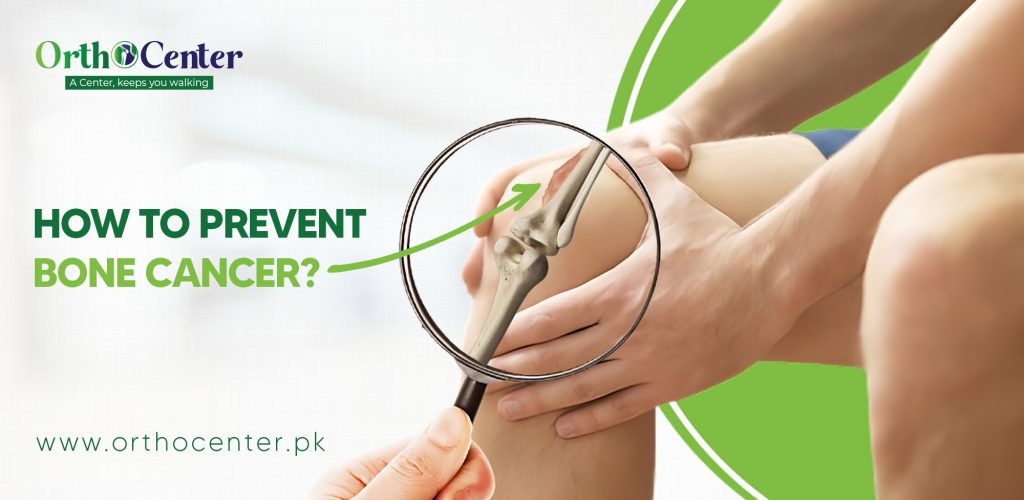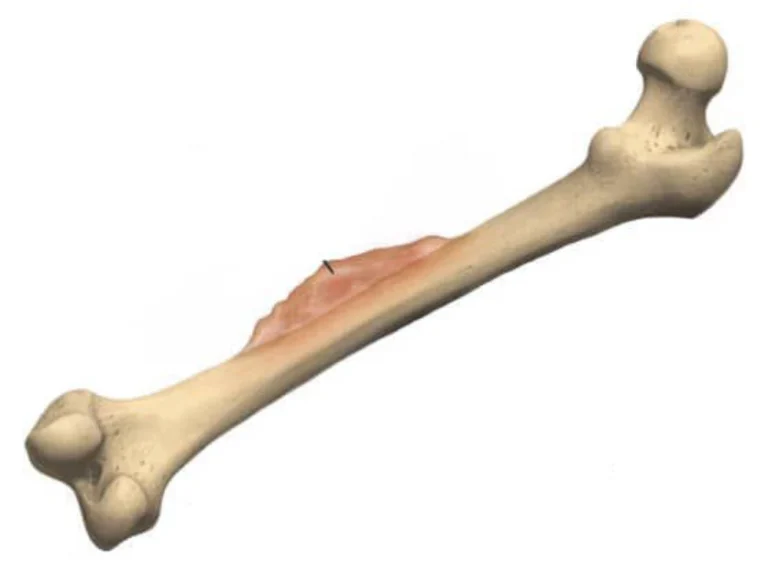Welcome to Our Orthopedic Clinic in Pakistan!

Health awareness is essential for the existence of healthier communities. In this aspect, it is important to face issues that don’t get talked about as often, like bone cancer. This terrible condition happens when abnormal development in bones gets out of control.
It not only damages bone health but also can lead to access to other parts of the body. Elevating the awareness of bone cancer is a matter of immense significance, because most folks just get into the untreatable stages of cancer because they could not identify the early symptoms. In developing countries like Pakistan, where prevention efforts and public awareness are still underscore, educating people about bone health, alertness, and early detection is essential to enhancing survival rates.
Dr Ahmed Shoaib at Orthocenter is committed to our goal of raising awareness and promoting bone wellness through early detection campaigns, community education, and expert orthopedic care. As a result, it enables people to protect their health with knowledge and foresight. The focus of this blog is to discuss the ways to prevent bone cancer and to have lasting future health.

Bone cancer can be put into two major categories. These are here
The main factor that determines the type of bone cancer is its origin. Primary bone cancer is one in which the bone tissue itself is the source. In truth, bone cells undergo abnormal changes and multiply uncontrollably. Though its occurrence is rare, it is often aggressive. For instance, osteosarcoma, chondrosarcoma, and Ewing’s sarcoma are the most prevalent.
Among affected people, the majority are children, adolescents and young adults during their growth period. Learning about symptoms indeed leads to early diagnosis. Hence, one can expect significant improvement in recovery prospects and preserve bone function through timely treatment.
Secondary bone cancer with other name metastatic bone cancer, occurs when cancer cells occupying bones come from other parts of the body. The common organ sources are the breast, lungs, prostate or kidney. In this case, the malignancy takes hold after travelling through the bloodstream or the lymphatic system. Moreover, the majority of cases of bone cancer belong to this type. Furthermore, it often indicates the advanced stage of the disease. Symptoms may resemble those of primary bone cancer; however, only thorough evaluations can give precise results. Additionally, it is generally not curable, but modern treatments can greatly improve the quality of life and slow disease progression.
| Primary Bone Cancer | Secondary Bone Cancer | |
|---|---|---|
| Origin | Bone itself | Other organs (e.g., lungs, kidneys) |
| Common Types | Osteosarcoma, Chondrosarcoma, Ewing’s Sarcoma | Metastases from breast, prostate, lung, kidney, or thyroid cancers |
| Frequency | Relatively Rare | More common |
| Age group affected | Children, teens, and young adults | Frequently older people |
| Symptoms | Persistent bone pain, swelling, tenderness, and fractures | Similar symptoms—bone pain, weakness, and fractures |
| Treatment | Radiation Therapy | Radiation Therapy, Hormone Therapy |
| Prognosis | Better if detected early and localized | Depends on the control of the original (primary) cancer |
The cause of many cancers is not known yet. When the DNA of cells in the bone or near it changes, it results in bone cancer. DNA contains the instructions that tell it what to do. In healthy cells, DNA is responsible for growth and multiplication at a predetermined rate. The instructions command the cells to die at a specific moment. In cancer cells, DNA mutations provide different instructions. The modifications instruct cancer cells to produce many more cells quickly. Cancer cells can live even when healthy cells die. This results in an abnormally large number of cells.
The cancer cells may develop a mass known as a tumor. The tumor can spread and destroy vital body tissue. Cancer cells can eventually break free and spread throughout the body. Metastatic cancer occurs when cancer spreads beyond the primary site.
Though people do it unconsciously, ignoring persistent pain can be a blunder, especially when it’s about bones. Unfortunately, bone cancer begins quietly. Early signs may look like symptoms of nutrient deficiency or work overload. Most folks feel tired and experience constant pain in their bones. However, with time intensity of signs increases and pain becomes worse, particularly at night or during movement. Swelling, a noticeable lump, stiffness and mobility reduction accompany the initial pain in the long run.
Thus, the things that need attention include;
Seeking immediate medical help is the only way to have a prompt diagnosis and to start the required treatment. Otherwise, things can go any direction, even to a medical emergency or death.
Diagnosing bone cancer is a sensitive and attention-requiring stage. The specialist starts it usually with a complete medical history, physical examination, and imaging tests. The most common tests include X-rays, MRIs, CT scans, and bone scans that help to determine the size and location of the tumor. An examination of tissue samples under a microscope and a biopsy are the final procedures used to identify the type of malignancy. Alkaline phosphatase and lactate dehydrogenase (LDH) levels are two examples of blood tests that may offer more information. Additionally, certain mutations can be found with the help of sophisticated molecular and genetic testing, which can be helpful in making personalized treatment strategies.
If you have to choose between prevention or cure, the answer will be evident. Preventing options seem extremely viable if the disease is severe, such as cancer. Hence, in the case of bone cancer, possible ways of prevention are no less than a blessing. Here is a brief overview of the ways that can help to prevent bone cancer.
Unexplained significant weight loss is high on the list of symptoms that indicate the presence of bone cancer. Hence, consistent monitoring of weight changes can contribute to the early detection of bone cancer. It can decrease the risk of complications and the severity of the issue. Moreover, in the early stages, less painful treatment options can be used.
Chances of occurrence of bone cancer increase in individuals having a history of disease or genetic syndrome in family members. It interprets that the person is carrying it in his genes. Hence, with the help of genetic counseling, planning strategies to prevent bone cancer may lead to fruitful results. It can not only reduce the probability of cancer but also promote the overall health status.
Frequent exposure to Ionization radiation, such as imaging or radiation therapy, can be significantly harmful to bones. They can affect the metabolism and natural healing process, leading to a risk of infections and weakening of bones. Hence, avoiding these radiations is crucial to having healthy bones and preventing the monster of cancer.
Taking care of yourself to enjoy a healthy life is incomplete without pampering bones. Keeping in mind the needs of bones, one must adopt methods to have adequate calcium and vitamin D. Intake of a nutritious diet or supplements and exposure to sunlight ( for some time if possible) can be helpful in this regard.
The workplace is of great importance in health discussions. Research proves that people working at places where exposure to chemicals or radiation is frequent often become prey to various cancers. It increases the risk of secondary bone cancer. Hence, compliance with guidelines and safety measures at workplaces is crucial to protect yourself.
Awareness of risk factors, genetic impacts, and the latest research and findings can promote the urge to adopt health-boosting methods. Moreover, it can contribute to preventing yourself from various severe medical issues in addition to bone cancer. Hence, use all sources to get maximum information and try to be updated.
The prominent risk elements concerning bone cancer include
One may face serious side effects of bone cancer if it remains unattended. Some significant consequences include reduced mobility, chronic discomfort, and fractures from weakening bones, particularly when it affects weight-bearing regions. Moreover, it could spread to other organs, such as the liver or lungs, making treatment more challenging. Beyond the physical troubles, bone cancer has a significant psychological effect, leading to severe anxiety and sadness. Thus, to avoid all and increase survival chances, early detection, and proper treatment are needed.
What you eat can be just as powerful as the treatment you receive. Patients struggling to overcome bone cancer need a diet that promotes healing and gives strength. It is an effective strategy to recover faster, maintain energy and support the immune system. Milk, yogurt, leafy greens and grains can be categorized as super foods when you are battling with bone cancer.
Fruits and vegetables with adequate antioxidants can even reduce inflammation. Some that can do wonders are berries, oranges and spinach. However, it is also crucial to be wise about what not to eat. These are
All the above food components can obstruct rehabilitation. If a patient is going through appetite issues, consulting a nutritionist can be a good strategy.
Every human is born with unique genetics. This is why the way of sending warning signals can vary from person to person. However, if you are experiencing persistent bone or joint pain or other symptoms mentioned above, you should not delay your visit to an orthopedic Surgeon. Apparently, simple symptoms could be a sign that something serious is going on beneath. Although it’s not necessary that it is always a progressive cancer, other diseases like arthritis can be controlled at an early stage.
Dr Ahmed Shoaib at Orthocenter has established his reputation as the leading surgeon possessing sharp clinical judgment and surgical skills. He, with his team, is dedicated to detecting issues early and helping you protect your mobility, comfort, and long-term bone health. Thus, do not delay visiting Orthocenter to ensure that your bone health is in safe hands.
Cancer is a medical condition that can turn the page of your life into an unexpected one. It can be anywhere in the body. However, its occurrence in bones can be a disaster as bone damage can restrict various movements. But problems always come with their solutions. There are possible ways that can aid in preventing bone cancer and keeping you safe from painstaking treatments.
These methods include taking care of your weight, avoiding radiation, and regular follow-ups. Moreover, paying attention to your genes will be of great help. In addition, keep your bones happy by providing the required nutrition and staying educated to know the risk factors and how to avoid them. Lastly, be positive and do not let stress ride your brain in order to maintain good mental health. Following all these ways, you can stay healthy and keep bone cancer away.
Find the top orthopedic clinic in Pakistan for comprehensive care. Expert treatments for bone, joint & muscle issues. Visit us for trusted solutions.
Ortho Center All Rights Reserved © 2025 Designed, Developed & Marketed by Marketing Agency for Orthopedic Surgeon
WhatsApp Us